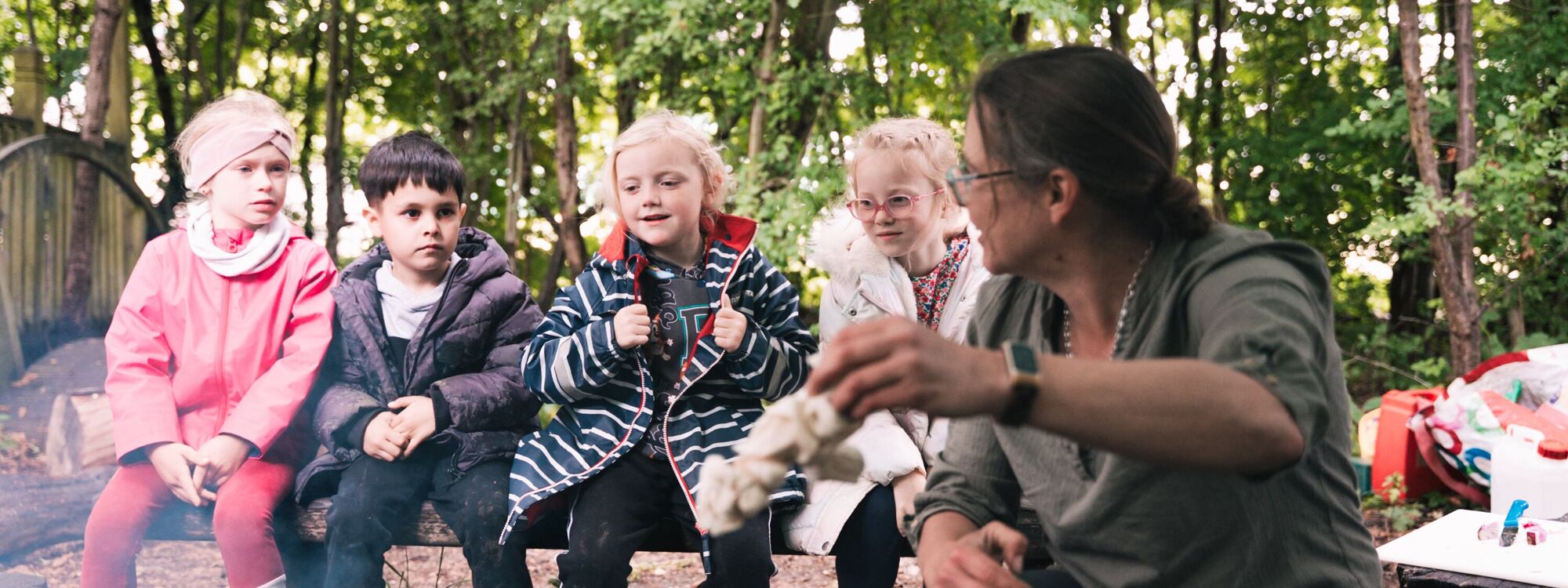- Home
- Learning
- Our Curriculum
- Forest School
Forest School
Part of our Forest School provision is units of works linked to other areas of the curriculum. Children deepen their learning through actively engaging in adventurous outdoor activities that make the most of our extensive outside resources.
Children in EYFS enjoy a Forest School session every half term that is linked to the topics they are currently learning. They learn how to be safe around fire and around the pond. They take age-appropriate risks, enjoy campfire stories, snacks and hot chocolate and learn through play-based challenges.
Units of work for other year groups are created at the teacher’s request to enhance learning. Some of examples of typical units are:
Year 1:
Our bodies and keeping healthy. This unit enhances the children’s learning in science about their bodies and how to stay healthy. The children also write simple recounts of their experiences in English. The children visit Furzefield Wood to make skeletons out of sticks, naming the bones in their bodies and use natural clay mud to create faces on trees. They sing songs and dance to reinforce the learning. At the school Forest School site, they create obstacle courses to challenge their bodies with different types of exercise and make and eat a healthy vegetable soup.
All about plants. This unit links to children’s learning in Science about plants. Children learn how to identify and find a number of common plants and learn about some of their uses. They make art using plants and have a go at tie dying using natural vegetable dyes.
Year 2
The Frost Dragon. This unit inspires children’s English by providing inspiration for their creative writing. In this unit, the children discover ‘clues’ that there has been a dragon in the Forest School area. They use clay and other natural materials to make dragons or weave willow to make dragon wings. They also cook ‘dragon tails’, made from a simple sweet bread dough, over a campfire.
The Great Fire of London. This unit deepens learning about the Stuart period in History. Children learn more about how Stuart houses were constructed by having a go at creating a wattle and daub panel. We re-create Pudding Lane with junk modelled houses and burn this down (in a carefully controlled conditions) to illustrate how the tightly packed nature of the street and the effect of the wind contributed to the rapid spread of the fire.
Year 3
The Stone Age. In this History linked unit, children have a go at using an ancient spear thrower called an atl atl. They try their hand at flint knapping, re-create some rock art and try an ancient grain porridge with berries.
Rainforests. This unit is linked to children’s learning in Geography and Science about the rainforest biome. Miss Roberts shares stories and pictures from her rainforest survival adventure in Guyana. The children then practise some key survival skills including stringing a hammock and lighting a fire.
Year 4
The Ancient Maya. This unit enhances the children’s learning in History through exploring aspects of ancient Mayan culture in a practical way. It also provides inspiration for recount writing in English. Children use cordage and found feathers to create Mayan style headdresses, make artists charcoal and use it to decorate themselves with Mayan style ‘tattoos’ and they recreate, in miniature, two of the field systems the ancient Mayans used for farming. They also try a recipe made with the three staples of the ancient Mayan diet: beans, squash and corn.
Ancient Greece. This unit enhances the children’s learning in History and English. We discover the story of Theseus and the Minotaur, make labyrinths using logs, make mythical monsters with clay and natural materials and make Greek inspired copper bangles using tiny anvils.
Year 5
Traditional Australian Stories. This unit enhances the children’s learning in Geography as part of exploring Oceania and environmental issues using a traditional Australian story as the ‘hook’. Children collaborate in teams to write ‘song lines’ as a form of natural navigation; they carry out work to improve the environment of the Forest School area and use tools to make ‘bull roarers’. These are then used in a final ‘ceremony’ in which children send a message about how we can take better of our planet.
Ancient Egypt. In this history linked unit, we build pyramids with large logs, solving the problem of how to move heavy objects safely and working as a team. We use charcoal to draw hieroglyphs and make recycled paper decorated with petals.
Year 6
Hedgerow harvest and traditional games. This unit is linked to the children’s study of WWII in history and English. As part of their learning about rationing, the children learn that there are abundant sources of vitamin C in the hedgerows. They process hawthorn berries to make fruit leather. They also think about simple games that children played in the past; they explore different ways of ‘curing’ conkers to make them stronger and have a conker competition.
For their final Forest School sessions, year 6 work together in ‘tribes’ creating a den, building a fire and making themselves a campfire snack.



